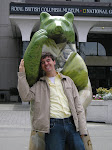Sunday, May 24, 2009, 3PM
Swarthmore College: Lang Concert Hall, Swarthmore, PA
Orchestra 2001 - James Freeman, conductor
There is something inherently strange, even challenging about the act of listening to music by a living composer. When discussing deceased composers, one benefits from the comfort of physical separation. In contrast, experiencing and evaluating a living composer's work is as much a social encounter as an artistic one.
This past Sunday, Orchestra 2001 gave the audience at Swarthmore College ample reason to feel challenged. They put on a polished, passionate concert of new and relatively new works, all by living composers. David Finko, Andrew Rudin, and John Corigliano, all born within three years of each other, represent a generation who grew up just as modernism was giving way to post-modern eclecticism. Even in their recent works, these composers retain a respect for the fundamentals of composition - form, orchestration, counterpoint - while seeking new modes of expression.
Moses, David Finko's 1971 concerto for piano and orchestra, was the only programmed work more than three years old, and it did stand out in certain regards. A prominent brass line led by the trombones opened the work. Brash melodic statements and a wide range of piano textures were reminiscent of a late Romantic sentiment dressed in new clothing. The music had a strong sense of dramatic purpose, with clear emotional goals and corresponding orchestrational colors.
Finko's Concerto for Piccolo and Orchestra (2006) definitely felt more contemporary, rather than Romantic or Modern. According to the program notes, the piece "...represents the mentality of Slavic people..." Finko avoided on-the-nose references that could be reasonably mistaken for actual folk material, yet he nevertheless succeeded in finding and expressing something true about the human experience. The virtuosic piccolo writing was superb.
I very much enjoyed Andrew Rudin's Concerto for Piano and Small Orchestra in Washington, DC, last year, so I came to his Concerto for Viola, Strings, Harp, Piano and Percussion (2007) with great anticipation. Rudin's style strikes me as a confluence of Romantic sentiment with Modernist tools and clarity - a gross oversimplification, of course. I'm not referring to late Romantics like Strauss or Mahler, but rather a conglomeration of drama and lyricism with contemporary craft and intellectual rigor.
The first movement of the Concerto featured a viola cadenza that was passionate and lyrical despite its disjunct contour - lyrical like a Webern piano piece played well. The double stops section was reminiscent of Ginastera's masterful Violin Concerto. In other spots - particularly in the third movement and the end of the first, the viola was virtually covered up by the orchestra. This highlights an important challenge posed by the instrument: How does one make the traditionally "accompanimental" viola into a compelling solo voice without falling back on obvious tricks such as extreme ranges or heavy extended techniques? Aside from the balance issues noted above, though, Rudin's strong writing largely answered this question.
While the final movement was more active and uptempo, the real standout portion of the work (and in some ways of the entire concert) was the second movement, particularly due to its orchestration. The timpani was used as a hand drum (a technique new to me!). Near the end, an extended suspended cymbal roll leading into the final viola recitative section formed an unexpected yet perfect transition. Finally, a major-major seventh chord coinciding with a tam-tam hit combined two of my favorite colors; I could honestly listen to just those two sounds for minutes on end. The final 90 seconds alone were worth the drive up from DC!
John Corigliano's Suite from The Red Violin (2007) was a fitting closer to a very fine concert. With Elizabeth Pitcairn reprising the soloist on the actual fabled "Red Violin" itself, the piece certainly has built up a powerful reputation. The program notes' description of the second movement as having "wild and colorful" textures with soft dynamics was a bit of an overstatement considering its reserved nature. It did, however, feature very idiomatic solo writing over top of fresh, densely-packed, quasi-tonal string harmonies.
Corigliano's acceptance of melody for melody's sake was featured throughout the composition, most notably in the third movement. The closing movement, though, is the most remarkable. The violin melody is of course prominent, but the real skill, as if often the case, lies in the background. "Fussy" string parts get us into the action as a flurry of soft, fast notes escape from a growing number of string parts. Minutes later, an impressive cadence channeling great violinists (and composers) of old at last comes to a close while those "fussy" string parts return and begin to die away. The accompaniment functions like a large-scale crescendo and decrescendo using texture and surface activity rather than dynamics. This movement probably appears graphically in the full score just like it sounds; white builds to black, holds steady, then tapers back to white and nothing. It's almost like Penderecki's Threnody, but with actual specific notes!
James Freeman, Artistic Director and Conductor of Ensemble 2001, did a superb job managing these four works. The orchestra was highly skilled and quite responsive to Freeman's baton, and, like much of the work they played, the result was an enviable mix of intelligent, moving music. If you missed this one, Orchestra 2001's next concert is September 25 and 27, 2009, in Philadelphia then Swarthmore, PA. Check out www.orchestra2001.org for more info.
Thursday, May 28, 2009
Review: Orchestra 2001 - May 24, 2009
Subscribe to:
Post Comments (Atom)


No comments:
Post a Comment